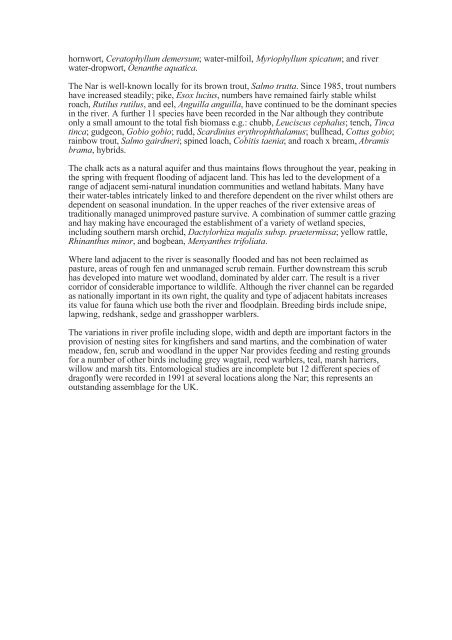APPENDIX 8A - National Infrastructure Planning
APPENDIX 8A - National Infrastructure Planning
APPENDIX 8A - National Infrastructure Planning
Create successful ePaper yourself
Turn your PDF publications into a flip-book with our unique Google optimized e-Paper software.
hornwort, Ceratophyllum demersum; water-milfoil, Myriophyllum spicatum; and river<br />
water-dropwort, Oenanthe aquatica.<br />
The Nar is well-known locally for its brown trout, Salmo trutta. Since 1985, trout numbers<br />
have increased steadily; pike, Esox lucius, numbers have remained fairly stable whilst<br />
roach, Rutilus rutilus, and eel, Anguilla anguilla, have continued to be the dominant species<br />
in the river. A further 11 species have been recorded in the Nar although they contribute<br />
only a small amount to the total fish biomass e.g.: chubb, Leuciscus cephalus; tench, Tinca<br />
tinca; gudgeon, Gobio gobio; rudd, Scardinius erythrophthalamus; bullhead, Cottus gobio;<br />
rainbow trout, Salmo gairdneri; spined loach, Cobitis taenia; and roach x bream, Abramis<br />
brama, hybrids.<br />
The chalk acts as a natural aquifer and thus maintains flows throughout the year, peaking in<br />
the spring with frequent flooding of adjacent land. This has led to the development of a<br />
range of adjacent semi-natural inundation communities and wetland habitats. Many have<br />
their water-tables intricately linked to and therefore dependent on the river whilst others are<br />
dependent on seasonal inundation. In the upper reaches of the river extensive areas of<br />
traditionally managed unimproved pasture survive. A combination of summer cattle grazing<br />
and hay making have encouraged the establishment of a variety of wetland species,<br />
including southern marsh orchid, Dactylorhiza majalis subsp. praetermissa; yellow rattle,<br />
Rhinanthus minor, and bogbean, Menyanthes trifoliata.<br />
Where land adjacent to the river is seasonally flooded and has not been reclaimed as<br />
pasture, areas of rough fen and unmanaged scrub remain. Further downstream this scrub<br />
has developed into mature wet woodland, dominated by alder carr. The result is a river<br />
corridor of considerable importance to wildlife. Although the river channel can be regarded<br />
as nationally important in its own right, the quality and type of adjacent habitats increases<br />
its value for fauna which use both the river and floodplain. Breeding birds include snipe,<br />
lapwing, redshank, sedge and grasshopper warblers.<br />
The variations in river profile including slope, width and depth are important factors in the<br />
provision of nesting sites for kingfishers and sand martins, and the combination of water<br />
meadow, fen, scrub and woodland in the upper Nar provides feeding and resting grounds<br />
for a number of other birds including grey wagtail, reed warblers, teal, marsh harriers,<br />
willow and marsh tits. Entomological studies are incomplete but 12 different species of<br />
dragonfly were recorded in 1991 at several locations along the Nar; this represents an<br />
outstanding assemblage for the UK.
















